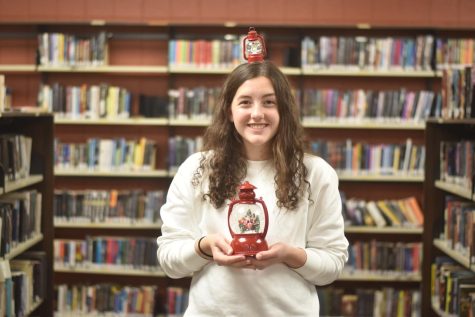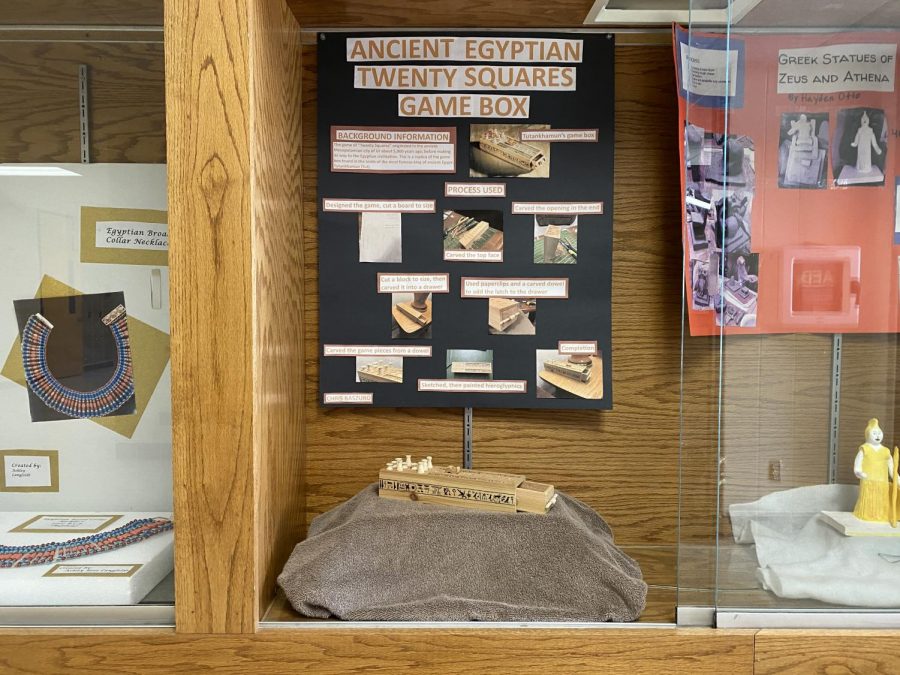Blast from the past
Seniors and juniors, in the age of technology, completed amazing Humanities semester projects the old school way.
Chris Baszuro’s Ancient Egyptian Game Board is one of many projects students created.
Technology is always evolving. This is one of the fundamental truths in our world seeing as humans are always trying to come up with ways to make everyday tasks easier and more efficient in hopes of making our lives better. It’s crazy to think that the first iPhone came out just thirteen years ago in 2007, especially considering that everywhere one looks, they see smartphones. But, just one century ago, people where marveling over the invention of a simple radio, and a century before that happened, Morse Code had yet to be invented. While it is important to keep on making progress, it is also beneficial to understand how technology worked in the past. Humanities students are doing just this by creating projects without any modern tools or supplies and, by stepping into the shoes of ancient people, many are discovering that “the simple life” wasn’t necessarily simpler.
Every semester, students are required to recreate an ancient craft, for first semester, this craft was to exist anywhere from the prehistoric to 900 AD. The project is designed to help students acquire stronger research skills, and also to get a better grasp on survival skills people needed back then. In addition to this, it gave students the opportunity to shed light on and try their hand at various “lost crafts” or even just skills that not very many people use anymore, such as knitting and stitching. Nicolette Hernke teaches Humanities at Cannon Falls and stated that “The project gives students a true understanding of how difficult and how amazing these things are. Somebody who is good at something makes it look simple, the end result looks excellent. So when students start chiseling away at some marble because they think they are going to do David they find out exactly how hard it is to be a sculptor.”
Alison Larson is a Humanities student, and for her project she recreated an Etruscan vase that was decorated with the Greek myth of Hercules’ second labor, slaying the Hydra. She spent a total of 42 hours on the project, through the actual creation of the vase, researching, and the making of her display and presentation. Once finished, she confirmed that “I’ve learned a lot about the evolution of Etruscan pottery and also that painting the designs that the Etruscans did was very difficult to do without using a potter’s wheel because there’s a lot of one-stroke, geometric designs that fill in the empty space.” Part of what makes the assignment so challenging is the inability of students to use tools that wouldn’t have existed when their craft was created, such as not being able to create Etruscan pottery using a potter’s wheel. Other projects included Oracle Bones, a Greek Crane, and an Egyptian game box.
Lack of access to modern tools allowed for students to fully appreciate the challenges that ancient people had, and once she created her vase, Larson remarked, “This project made me realize how much pottery means to civilizations. Not only the Etruscans, but many other civilizations that put so much time and energy into making and decorating vessels such as the one I remade. I appreciate pottery a lot more now.” Hernke agreed in the sense that producing the project gave students a different look at a time period where technology wasn’t so common. “Technology is wonderful. However, hands on skills are still extremely important for a person’s mind because it exercises something different than when you’re looking at a computer screen.”
Overall, technology has changed a ton since the first humans walked the planet, and is continuing to evolve today. By creating their projects in Humanities, many students are given the chance to fully learn about and appreciate technology through the ages.

Hi Everyone! My name is Lauren Ritz and I'm a senior editor-in-chief for the Lantern. When I'm not editing articles and cooking up graphics, I enjoy playing...

